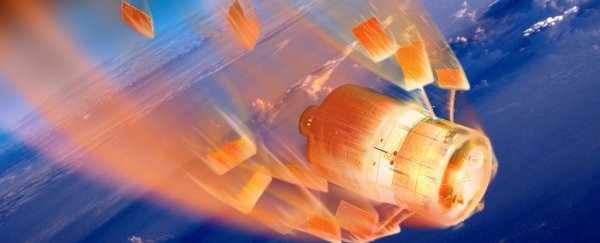At any given moment, thousands of satellites swarm over our heads at altitudes ranging between a few hundred miles and tens of thousands of miles.
But, of the manmade items in space that are larger than your fist, orbiting satellites are a minority. About 95 percent of what's out there is space junk: out-of-control space stations, used rocket parts, dead satellites, lost astronaut tools and more.
This dangerous orbital garbage is moving roughly 10 times faster than a speeding bullet and takes a long time to crash back to earth.
"This debris can stay up there for hundreds of years," Bill Ailor, an aerospace engineer and atmospheric reentry specialist, told Business Insider.
And it gets worse.
Just one collision in space can create thousands of new high-speed, out-of-control pieces and threaten other spacecraft.
Meanwhile, perhaps 170 million pieces of debris larger than 1 millimetre - such as flecks of paint and bits of explosive bolts - move around Earth at tens of thousands of miles per hour, according to the European Space Agency.
"Countries have learned over the years that when they create debris, it presents a risk to their own systems just as it does for everybody else," said Ailor, who works for the nonprofit Aerospace Corporation.
The chart below, which Business Insider created using data from Space-Track.org (registration required), shows the top 10 entities with the most trackable objects around Earth as of October 2017.
The chart shows Russia has the most objects currently in space, numbering more than 6,500 objects. However, it's not the biggest contributor to space junk, shown in red.
The US owns the title of dirtiest country in space for now, and just by a hair. Russia has 3,961 pieces of detectable space debris compared to the 3,999 pieces of trackable space trash in orbit created by American activity.
China has only recently ramped up its space program, yet it's in a close third with 3,475 hunks of space junk. This is because the nation in 2007 destroyed one of its own satellites in an anti-satellite weapons test.
This highly controversial move instantly created more than 2,300 trackable pieces of junk, more than 35,000 pieces larger than a thumbnail, and perhaps hundreds of thousands of pieces too small to track.
How to clean up outer space
Getting old spacecraft out of orbit is a key to preventing the formation of space junk, and many space agencies and corporations now build spacecraft with systems to de-orbit them.
But Ailor and others are eager to push the development of new technologies and methods that can lasso, bag, tug, and otherwise remove the old, uncontrolled stuff that's already up there and continues to pose a threat.
"I've proposed something like a XPRIZE or a Grand Challenge, where would you identify three spacecraft and give a prize to an entity to remove those things," he said.
The ultimate goal is to prevent an alarming scenario known as Kessler Syndrome: when so much stuff is in space, one collision leads to several others, and those crashes lead to even more - littering space with so much debris that it becomes incredibly risky to leave Earth.
The biggest hurdle in defeating space debris, however, is likely human.
"It's not just a technical issue. This idea of ownership gets to be a real player here," Ailor said. "No other nation has permission to touch a US satellite, for instance. And if we went after a satellite … it could even be deemed an act of war."
Ailor said someone needs to get nations together to agree on a treaty that spells out laws-of-the-sea-like salvage rights to dead or uncontrollable objects in space.
"There needs to be something where nations and commercial authorities have some authority to go after something," he said.
This article was originally published by Business Insider.


